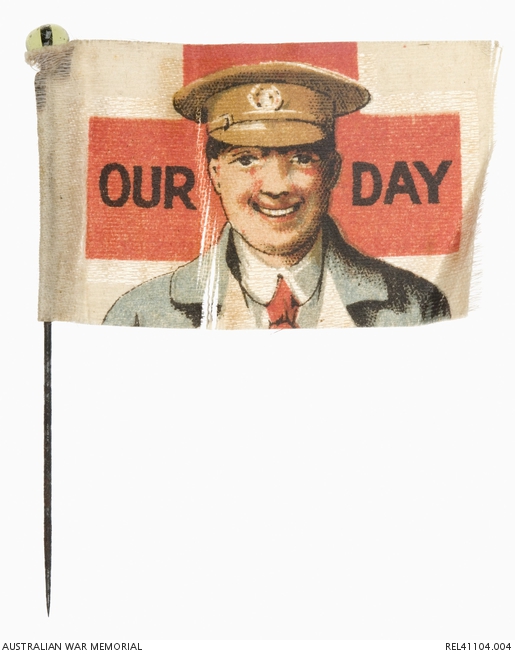| Place | Europe: United Kingdom, England |
|---|---|
| Accession Number | REL41104.004 |
| Collection type | Heraldry |
| Object type | Badge |
| Physical description | Glass, Metal, Silk |
| Maker |
Unknown |
| Place made | United Kingdom: England |
| Date made | c 1917 |
| Conflict |
First World War, 1914-1918 |
Fundraising badge, Red Cross 'Our Day' : Private F J Knapman, 34 Battalion AIF

Miniature rectangular silk flag design mounted on a long metal pin with a clear green glass ball top. Silkscreened in full colour, the design depicts the head and shoulders of a smiling British soldier in cap and hospital blues superimposed on a Red Cross bearing the words 'OUR DAY'. The silk has split longitudinally.
One of a collection of some fifty fundraising and patriotic badges purchased and collected in England in 1918 by 3331 Lance Corporal Frederick John Knapman, born Sydney, NSW in April 1898, a farmer of Leeville via Lismore, NSW. Knapman enlisted on 17 May 1917 at Lismore, requiring the permission of his parents to do so - both John & Mary Knapman's signatures appear on his application. He was assigned to 34 Battalion on 27 June 1917 and embarked for overseas service from Sydney aboard the transport 'Port Melbourne' on 16 July.
His training commenced at 9 Training Battalion at Durrington upon his arrival in England. He left Southhampton for France on 17 January 1918, travelling via the Australian Infantry Brigade Depot at Rouelles to join his battalion in the field.
When the German Army launched its last great offensive in the spring of 1918, the battalion was part of the force deployed to defend the approach to Amiens around Villers-Bretonneux. It took part in a counter-attack at Hangard Wood on 30 March, and helped to defeat a major drive on Villers-Bretonneux on 4 April. By 16 April Knapman had been promoted to Lance Corporal. On 9 May his battalion was in line at Franvillers near the Bray-Corbie Road. The previous few days had seen concerted efforts by the battalion to dislodge the Germans from trenches and positions on the other side of the road, but on 9 May relatively little happened - enemy snipers were being 'beaten down' and the enemy fired gas later that night. Lance Corporal Knapman unluckily received a gunshot wound to his left buttock and was evacuated from the line.
He was admitted to the Stratford-on-Avon War Hospital where he underwent treatment; he was sufficiently recovered by 19 June to be granted leave until 3 July. He was gradually returned to the lines via 1 Convalescent Depot and the Overseas Training Brigade at Longbridge before rejoining his unit on 18 September 1918. He remained with 34 Battalion until the Armistice. During late 1918 and early 1919 Knapman took advantage of the training opportunities being offered in England and attended agricultural school until March 1919. He went absent without leave (AWL) for nine days in August 1919 from the AIF's Sutton Veny camp, losing his Lance Corporal stripes as punishment. He embarked a month later for return to Australia aboard the transport 'Plassey' arriving in Sydney on 30 October 1919 and was discharged from service on 10 December.
Knapman collected these fundraising badges when he was convalescing at Stratford-on-Avon between May and July 1918. They provide a representative cross-section of English wartime fundraising organisations and activities, with examples from the British and French Red Cross, YMCA, Royal National Life-Boat Institution, Salvation Army, RSPCA, Queen Alexandra's Field Force Fund, Lord Roberts Memorial Workshops, various Flag Days, Dr Barnardo's Homes, WAF Canteens, St Dunstan's Hostel for Blinded Soldiers and Sailors, the National Society for the Prevention of Cruelty to Children, as well as a selection of patriotic themes.
This particular example marks 'Our Day' - the Red Cross and the Order of St John's combined annual fundraising appeal which was first held on 21 October 1915. A report on the progress of the appeal in the October 1917 edition of 'The British Journal of Nursing' stated 'success ...was assured from the first by the splendid donations received at Red Cross Headquarters, including 10,000 pounds from the King and 205,000 pounds from the British Chapter of the Red Cross. Altogether donations, apart from street sales, considerably exceed 700,000 pounds'.